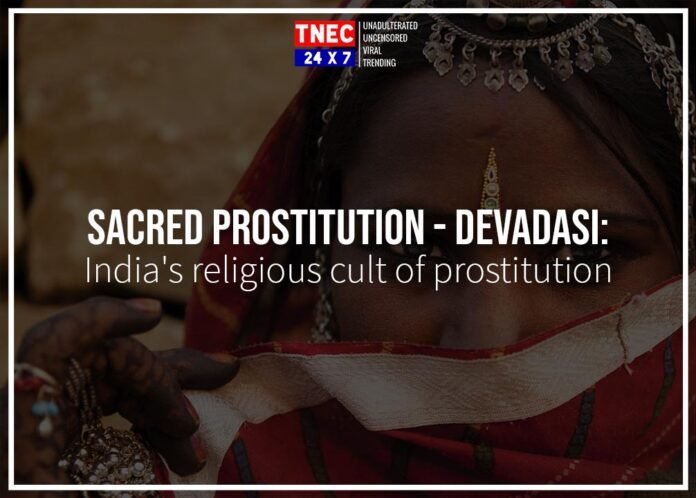Article by: Subhayu Bhadury, The North-Eastern Chronicle
Visual by: Kunal Kaustav Duwarah
Devadasi or Devaradiyar translates to “servant of God.” Because these women were committed to God and deemed given in marriage to God, they were unable to marry any ‘mortal.’
They were, however, free to pick their mates from a pool of married and unattached males. These partnerships might last a long time or only last a few months.
These women, on the other hand, were not financially dependent on their boyfriends. They learnt music and dancing, as well as up to 64 different forms of art.
They would perform dances and songs at temples or in front of kings in exchange for wealth and land. Some people have chosen to devote their entire lives to God and have never had a companion.
Also read: Read about the prevalent gender segregation in remote villages of India! Are the people ready for any change?
Origin of Devadasi Practice

The ‘Devadasi’ method has been practiced in India since the 6th or 7th century. Devadasi is a Sanskrit term that means “God’s female servants.” The old devadasi system was held in great regard, and women were accorded high status.
Women who were highly talented and literate were called devadasis of God, submitting fully to the almighty.
This religious rite has been tampered with over the years. Lower-class women and children have been linked to this practice, and they are sexually exploited and forced to engage in prostitution to survive.
The actual origin of the devadasis is uncertain, although according to legend, a girl called Amrapali was the first to be mentioned as a devadasi.
She was known in ancient India as the Nagarvadhu. The most skilled and attractive woman picked by the monarch and his reign was Nagarvadhu. She was regarded as a Goddess, even though she was a prostitute known for her musical and dancing abilities.
The Chola kingdom embraced the devadasi system, which spread throughout southern India.
Devadasis held a prestigious status in society between the 6th and 13th centuries. Because they were wedded to the deity, the devadasis were deemed auspicious. They were regarded as goddesses in their own right, with the ability to regulate natural human urges.
The colonial era’s depiction of the Devadasi system

During the invasion of Islamic and British authority, the dignity of devadasis began to erode. When the Islamic rulers began deconstructing Hindu temples, the devadasis lost their clients’ funding and their position.
Dancing was associated with prostitution, and British reformers promoted the devadasis as prostitutes to further their political careers.
Many British troops were exposed to venereal diseases in brothels during colonial control, and the devadasis were mistakenly blamed. Because the British authority removed the rulers and patrons who supported the old devadasi system, this group was exploited and marginalised.
The Devadasis as seen in today’s society

The devadasi system was legally abolished in all areas of India by 1988, following India’s independence in 1947. However, the most disturbing finding is that this practice is still practised in areas of southern India.
Sex trade, prostitution, and exploitation of the lower caste have all been reduced to the ancient system of temple dance and praising God.
These women find themselves at a crossroads, caught between impossible societal standards and destitution. They are unable to marry since they are married to the deity, and by the age of 40–45, men have stopped approaching them.
They either became sick and became weak, contracted HIV, or died.
Thousands of young girls between the ages of five and ten devote themselves to Goddess Yellamma every year.
Why is India’s devadasi tradition still alive and well?
In twenty-first-century India, religious beliefs, economic pressure, and social construction intertwined to practise this repulsive system. Because of religious beliefs, the poor think that sending their young daughter to become a devadasi will bring their family benefits.
They would be free of poverty, and their social standing would improve. Being married to a deity would raise their social position, and they would not be considered second-class citizens.
Economic strain also impacts the majority of lower-class employment who are low-wage and insufficient to support their families. As a result, people are compelled to do it to make money.
Social pressure has also impacted many upper-class landowners who regard having sex with young virgin females as their prerogative, and their philandering conduct reflects their grandeur and riches.
According to the National Commission for Women in India, there are about 400 thousand devadasis in India, with most of them living in the Indian states of Andhra Pradesh and Karnataka. In comparison to the national average, devadasi girls have a shorter life expectancy.












